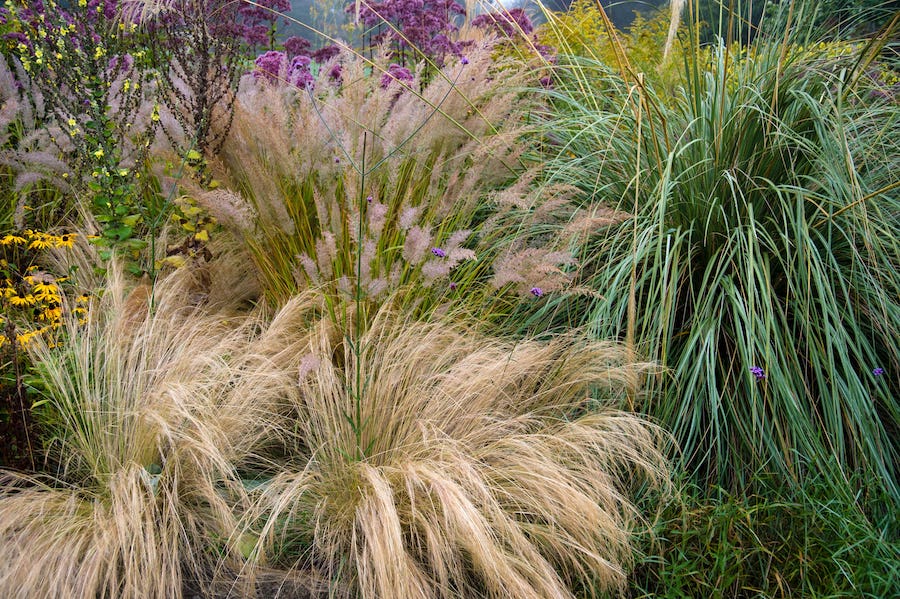5 ornamental grasses to add movement to your garden
Their textures, feel and rich colours add interest as other plants fade
As summer continues, ornamental grasses come into their own, providing a contrast of textures, movement and rich colours in an array of schemes, whether repeat-planted in borders, or as stand-alone specimens in large containers or gravel gardens.
Grasses are not only grown for their wispy foliage, but also for their decorative feathery flowerheads which often last through autumn and into winter, while their seedheads offer interest through the cooler months.
- Early bird saving! Save an extra 10% on Autumn Bedding Plants with YouGarden
- Early bird saving! Save an extra 10% on Spring Flowering Bulbs with YouGarden
They calm down a garden sizzling with colour as they encourage the eye to pause before continuing into the mixture of colours. Their linear forms and pretty seedheads also contrast with many leaves and flowers and many even look good when they have dried out in winter.
So, which types should we be considering? Here are five varieties recommended by the RHS.
1. Stipa gigantea
View this post on Instagram
Give this robust evergreen plenty of space to shine, as huge stems of large, golden, oat-like flowers appear in late spring above dark evergreen foliage, lasting through summer and into winter. It grows up to 2m in height so makes a brilliant alternative to pampas grass.
Where to plant it: It can easily be made a stand-alone focal point in a lawn, or provides great architectural appeal in a gravel garden.
2. Miscanthus sinensis ‘Kleine Silberspinne’
View this post on Instagram
Feathery reddish flower heads emerge from compact clumps of arching narrow leaves with a white stripe in summer. In autumn, the flowers turn pale brown and later silvery, lasting into winter. It can reach a height of around 1.2m but is compact so you won’t need a huge amount of space to grow it.
Where to plant it: It’s a versatile perennial grass, so will be equally at home in the middle of a border as it will in a tight urban space, providing architectural interest in a city garden, even in a pot. If you’re growing it as part of a border scheme, think about planting burnt orange Helenium ‘Moerheim Beauty’ nearby for a striking contrast.
3. Anemanthele lessoniana
View this post on Instagram
Pheasant’s tail grass, originally from New Zealand, is semi-evergreen with gold and orange autumn-winter colour. It forms a fine-leaved fountain-like clump of foliage which changes during the seasons to yellow, orange and red streaking. Sprays of airy flowerheads appear in late summer.
Where to plant it: Grow it in full sun or partial shade, partnering it with crocosmia, achillea, Geranium ‘Rozanne’ and other ornamental grasses.
4. Pennisetum villosum
View this post on Instagram
This pretty grass forms bright green tussocks topped by short, wide furry white flowers throughout summer and autumn. It’s often grown as an annual as it is on the tender side, although it should survive outdoors in sheltered spots.
Where to plant it: It looks lovely in a mixed container combined with burgundy flowers such as annual Verbena ‘Diamond Merci’ or deep purple Allium sphaerocephalon.
5. Ophiopogon planiscapus ‘Nigrescens’
View this post on Instagram
So, not your regular ornamental grass, but an easy-to-grow, clump-forming evergreen that produces low growing tufts of very dark purple, almost black blades.
It’s a small plant, perfect for containers or in a rock garden or raised bed, where it won’t be lost, producing small white flowers in summer and black berries in autumn.
Where to plant it: In tubs or a gravel garden, contrasting it with silvery plants in sun or vibrant green ferns in shade.
When planting… Grasses generally prefer drier soil and sunny conditions. If you’re planting them in a pot, it needs to be well-drained, so put some crocks in the bottom of the pot before filling it with compost. When the grass is in, top-dress the soil with slate chippings or loose gravel to stop water gathering at the crown of the plant, which will cause it to rot.
And in pots…

For containers filled with colourful foliage, you might try Imperata cylindrica ‘Rubra’ (Japanese blood grass), which has lime green leaves tipped with bright red, which reaches about 45cm in height and is slow growing. It does best in a sunny spot in fertile, moist, well-drained soil. In colder areas it may need winter protection.
Another good bet for a tall container is Hakonechloa macra ‘Aureola’, a deciduous low-growing grass with lemon and lime striped leaves which flush pink, then red purple in autumn. Make sure you keep it well-watered, but not soggy.
The Press Association
Latest posts by The Press Association (see all)
- Dame Kelly Holmes: ‘Getting old is a privilege but ageing I don’t like’ - April 27, 2024
- 9 of the most iconic dance scenes in movies - April 27, 2024
- Why is melanoma on the rise? As new personalised ‘gamechanger’ skin cancer jab is tested - April 27, 2024
- King to resume public duties after positive cancer treatment - April 26, 2024
- 3 recipes to make from the new Hairy Bikers cookbook - April 26, 2024





















